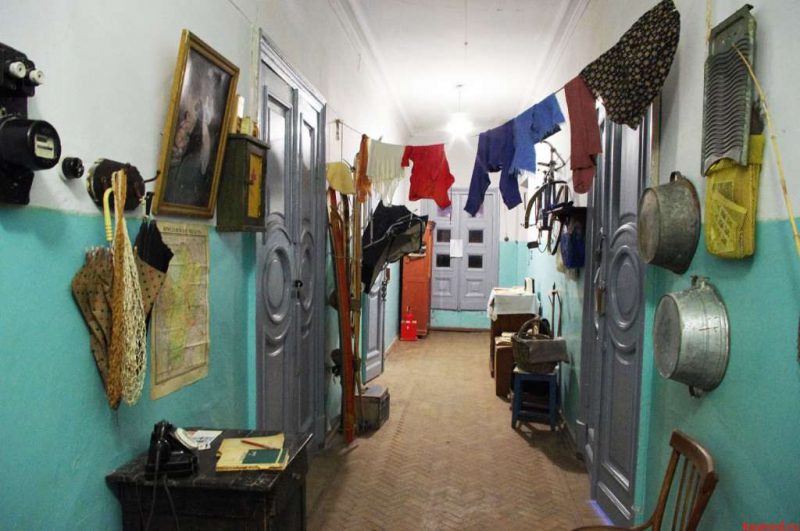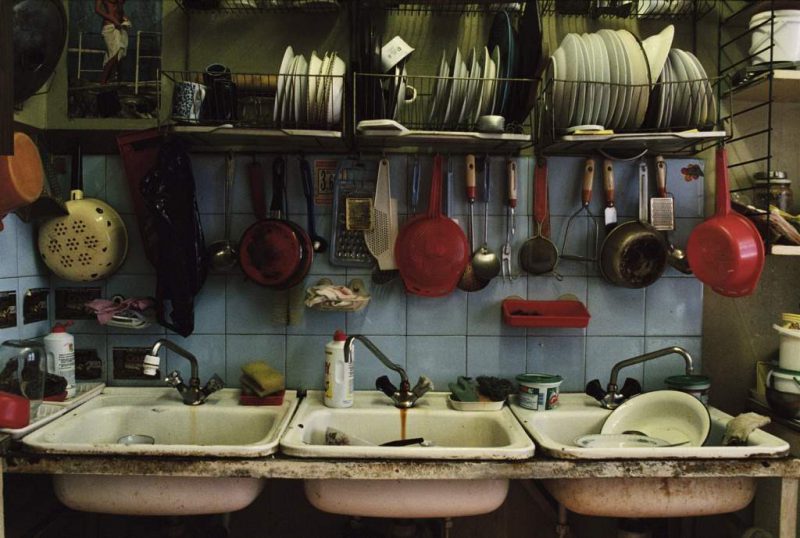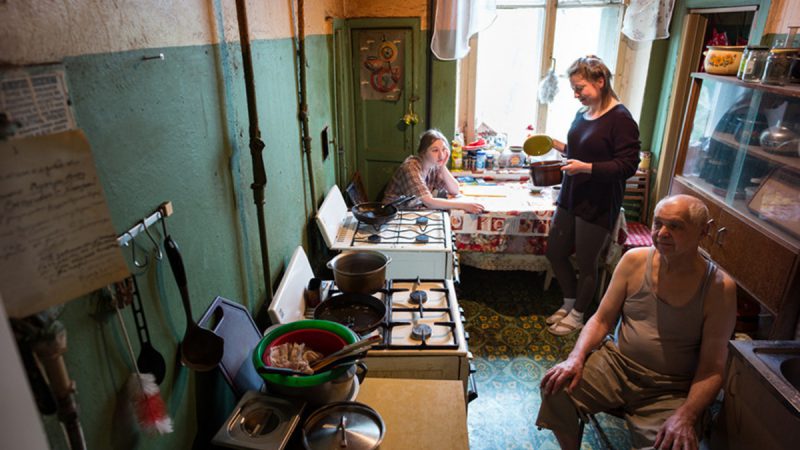Communal apartments as part of Russian history
Over the decades, communal apartments in Russia have become not only a type of housing but also the subject of research by anthropologists, historians and sociologists. What are communal apartments? Do they exist in modern Russia? What is so interesting about this phenomenon? Let’s find out!

Precursors of communal apartments
Despite common misconception, the communal apartment is not the invention of the Soviet period. The first prototypes of communal apartments appeared in Russia in the 18th century: the owners of small houses used to divide a floor in their building into 3-6 parts and rent it out. Several family-neighbors who rented such a space were living together in a relatively small area where they had to share a kitchen and a toilet. Sometimes people did not have enough money to even rent a room, then the house owners rented a corner – a small space in the corridor or on the staircase which was only big enough to arrange some sort of a bed.
Such apartments, however, were not called “communal” yet but had a beautiful name “furnished rooms”.
The trend towards the creation of communal apartments started in the 19th century due to the industrial growth in Russia and Europe. The workers used to unite in small groups to rent together several rooms in a big apartment. This connection by personal acquaintance or profession is a distinctive feature of this period of history of communal living in Russia. Joint rent was a common practice for not only some workers, but also for students, beginning artists or sculptors. The rent, however, was still quite expensive, and most workers could not afford to live in the comfort of apartments and lived in wooden barracks on the outskirts of the city which were also divided into rooms and corners.
The 1917 revolution. The beginning of communal apartments
The term “communal apartment” entered in the Russian language after the 1917 Revolution. Bolsheviks, who overthrown the royal power, soon faced the problem of human settlement. Before the first five-year plan was launched and the mass construction of residential areas began, the Bolsheviks implemented the measure which is now called the “consolidation”. The consolidation was the forcible removal of “surplus living space” from wealthy homeowners with the aim of settling the workers from the outskirts.
The first step to consolidation was the law on the abolition of private ownership of real estate in cities. Due to this law, the homeowners lost the rights to their homes, and the living space was distributed among the workers and the peasants who came to work in the city.
The consolidation policy was justified by the Bolsheviks as “the principle of finding and providing workers with living quarters at the expense of bourgeois parasitic elements”. The first result of this “principle” was the fact that only in the fall of 1918, 3197 “bourgeois families” (about 15000 people) were evicted from Moscow, and over 20000 workers moved into their apartments. Over the next 6 years, about 500 thousand people in Moscow and 300 thousand people in Petrograd (now Saint-Petersburg) were settled into comfortable apartments. However, soon the cities started running out of space again, and the earlier allocated living space was reduced. So, in 1926, the sanitary standard per person was 13.5 meters, and by 1931 it was reduced to 9 meters per person. Such a tangible decline in the residential standard was brought about by a large influx of people from villages and rural areas into large cities.
The second wave of settlement of communal apartments
The second stage in the history of communal apartments was the postwar period. At the end of the Second World War, the Russian cities presented a depressing sight: destroyed, bombed, and burnt houses, demolished residential quarters. The inhabitants of the cities had no choice but to re-consolidate themselves. It was during these postwar years that the phenomenon of mass communal apartments flourished and lasted until the early 1970s.

A communal apartment was a kind of closed micro-society with its own strict and specific rules that had to be followed. Each communal apartment had a chairman whose task was to establish order inside the apartment and to make sure it’s followed. Various rules were introduced for the normal functioning of a communal apartment: for example, a shiftable cleaning schedule, a cooking schedule, a shower and washing schedule, etc. Each member of this communal society should have understood that not only his own comfort, but the entire life of this micro-society depended on compliance with the rules. Often, non-compliance with the established schedule, as well as the difference of characters caused scandals and disagreements among residents of communal apartments.
This new communal society was very different from the one in 19th century where people of the same profession united to rent rooms and live together. The post-war communal apartments no longer followed that principle. People of different professions and education level lived in the same apartment at the same time: teachers, doctors, factory workers, postmen, porters, etc. It was also people of different ages and nationalities. Often one of the rooms was occupied by somebody with alcohol dependence or parasites which markedly complicated the life of all the other neighbors. However, settling marginal elements together with other people made it possible to ensure better control and safety of people and premises (just imagine what could happen if several people dependent on alcohol lived in the same apartment).
A new stage in the life of people: personal apartments
Mass residential construction began in the late 1960s and 1970s. As one of the characters of the movie “The Pokrovsky Gate” said, it led to “the exodus of people from common hives into personal nests”. The construction of housing was only partially public: the factories, institutes, and other enterprises also financed the construction of houses for their employees. Often the employees even participated in building their own houses. The construction was typical and therefore fast. Thanks to this type of construction, large residential areas were built in all cities of the Soviet Union and most of the citizens could move there.
The end of the Soviet era and nowadays
The collapse of the Soviet Union has given rise to many problems in all spheres of life of the Russian people and the housing was not an exception. Most of the construction projects were frozen, and with the country transition to a new type of economy, many residents of communal apartments lost their hope to be resettled one day. The private companies that were now involved in housing construction allocated significantly lower number of apartments in their built-up arrays to resettle communal apartments.

For those who still share apartments with other families and people, the life is often accompanied by a number of problems, for example:
– As a rule, communal apartments were organized in the old buildings which require major repairs both outside and inside the building, the people living there often do not have enough money to renovate even their rooms and common areas (kitchen, bathroom, toilet);
– Many of the old buildings were built in 19th and the beginning of 20th century by the standards of that time, therefore many of them, for example, don’t have a special place for a bathroom. It’s quite common for the communal apartment to see a bathtub in the kitchen or a shower cabin in the backstairs as there is no other place to put them;
– Often, communal apartments become a home to problematic people that cause a lot of headache to their neighbors. Also, the general culture of everyday life in communal apartments today is significantly lower than that in the Soviet years.
The resettlement of the communal apartment is still a topical issue for many big Russian cities. Saint-Petersburg is still recognized as the Russian capital of communal apartments (75-80 thousands). In some cities, the local governments found original ways to address the problem. In the same Saint-Petersburg, for example, the communal apartments on Vasilievsky Island where the oldest buildings are located were given a status of hotels. Now tourists who want to see this phenomenon of communal apartments with their own eyes can book a room for themselves and get closer to the authentic atmosphere. Other communal apartments are preserved and become museums, where you can immerse yourself in the life of the recent Soviet past.
Conclusion
We have told you the story of communal apartments – a significant part of late Russian history and the life of many Russian people until these days. Do you have a history of communal apartments in your country? Let us know in the comment, we are curious to know!

Culturologist, professor of Russian as a foreign language and promoter of Russian culture.
Aleksandra gives Russian lessons via Skype.






I’m a Russian Jewish immigrant from Latvia, from 1980. I remember living in a communal apartment with my mother, sharing one room, while another family, Latvian family in the medical profession, of maybe 4 or 5 , occuppied the rest of the rooms. I was a child then and my memory is prety narrow. But I do remember, our apartment had a separate bathroom from a toilet and sink room. Then there was a kitchen with separate stoves, and I guess sinks, and maybe some counter space. I don’t remember how it all was arranged. That’s why I researched and found your article. It was very informative and brought back some memories.
Hi Roza,
Thanks for your comment, very interesting. 🙂